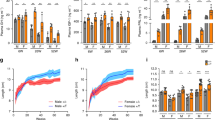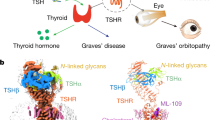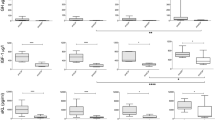Abstract
Advances in the diagnosis and treatment of growth hormone insensitivity disorders have occurred in the past 15 years. We discuss the current status of endocrine and molecular evaluation, focusing on the pediatric age range. All the identified mutations of the growth hormone receptor are included. Treatment with recombinant human insulin-like growth factor (rhIGF) 1 in classical cases is summarized and new targets for treatment are discussed, together with therapy using the complex formed between rhIGF1 and rhIGF-binding protein 3.
Key Points
-
Growth hormone insensitivity disorders represent a broad category of clinical, endocrine and genetic abnormalities
-
A definitive list of the known mutations in the growth hormone receptor that occur in patients with growth hormone insensitivity is included in this article
-
Recombinant human insulin-like growth factor 1, or the complex of recombinant human insulin-like growth factor 1 plus insulin-like growth-factor-binding protein 3, is effective as growth-promoting therapy for children with growth hormone insensitivity disorders, and offers hope of long-term benefits
This is a preview of subscription content, access via your institution
Access options
Subscribe to this journal
Receive 12 print issues and online access
$209.00 per year
only $17.42 per issue
Buy this article
- Purchase on Springer Link
- Instant access to full article PDF
Prices may be subject to local taxes which are calculated during checkout


Similar content being viewed by others
References
Laron Z (2004) Laron syndrome (primary growth hormone resistance or insensitivity): the personal experience 1958–2003. J Clin Endocrinol Metab 89: 1031–1044
Berg MA et al. (1994) Receptor mutations and haplotypes in growth hormone receptor deficiency: a global survey and identification of the Ecuadorean E180 splice mutation in an oriental Jewish patient. Acta Paediatr Suppl 399: 112–114
Rosenfeld RG et al. (1994) Growth hormone (GH) insensitivity due to primary GH receptor deficiency. Endocr Rev 15: 369–390
Woods KA et al. (1997) Phenotype : genotype relationships in growth hormone insensitivity syndrome. J Clin Endocrinol Metab 82: 3529–3535
Burren CP et al. (2001) Clinical and endocrine characteristics in atypical and classical growth hormone insensitivity syndrome. Horm Res 55: 125–130
Attie KM et al. (1995) Evidence for partial growth hormone insensitivity among patients with idiopathic short stature. The National Cooperative Growth Study. J Pediatr 127: 244–250
Selva KA et al. (2003) Reproducibility in patterns of IGF generation with special reference to idiopathic short stature. Horm Res 60: 237–246
Blair JC et al. (2004) Standard and low-dose IGF-I generation tests and spontaneous growth hormone secretion in children with idiopathic short stature. Clin Endocrinol (Oxf) 60: 163–168
Bazan JF (1990) Structural design and molecular evolution of a cytokine receptor superfamily. Proc Natl Acad Sci USA 87: 6934–6938
Brown RJ et al. (2005) Model for growth hormone receptor activation based on subunit rotation within a receptor dimer. Nat Struct Mol Biol 12: 814–821
Choi HK and Waxman DJ (2000) Pulsatility of growth hormone (GH) signalling in liver cells: role of the JAK-STAT5b pathway in GH action. Growth Horm IGF Res 10 (Suppl B): S1–S8
Godowski PJ et al. (1989) Characterization of the human growth hormone receptor gene and demonstration of a partial gene deletion in two patients with Laron-type dwarfism. Proc Natl Acad Sci USA 86: 8083–8087
Shevah O et al. (2003) Identification of two novel mutations in the human growth hormone receptor gene. J Endocrinol Invest 26: 604–608
Pantel J et al. (2003) Heterozygous nonsense mutation in exon 3 of the growth hormone receptor (GHR) in severe GH insensitivity (Laron syndrome) and the issue of the origin and function of the GHRd3 isoform. J Clin Endocrinol Metab 88: 1705–1710
Amselem S et al. (1991) Recurrent nonsense mutations in the growth hormone receptor from patients with Laron dwarfism. J Clin Invest 87: 1098–1102
Amselem S et al. (1993) Spectrum of growth hormone receptor mutations and associated haplotypes in Laron syndrome. Hum Mol Genet 2: 355–359
Berg MA et al. (1993) Diverse growth hormone receptor gene mutations in Laron syndrome. Am J Hum Genet 52: 998–1005
Putzolu M et al. (1997) A homozygous nonsense mutation of the human growth hormone receptor gene in a Sardinian boy with Laron-type dwarfism. J Endocrinol Invest 20: 286–288
Sobrier ML et al. (1997) Nine novel growth hormone receptor gene mutations in patients with Laron syndrome. J Clin Endocrinol Metab 82: 435–437
Tiulpakov A et al. (2005) A novel C-terminal growth hormone receptor (GHR) mutation results in impaired GHR-STAT5 but normal STAT-3 signalling. J Clin Endocrinol Metab 90: 542–547
Goddard AD et al. (1995) Mutations of the growth hormone receptor in children with idiopathic short stature. The Growth Hormone Insensitivity Study Group. N Engl J Med 333: 1093–1098
Kaji H et al. (1997) Novel compound heterozygous mutations of growth hormone (GH) receptor gene in a patient with GH insensitivity syndrome. J Clin Endocrinol Metab 82: 3705–3709
Quinteiro C et al. (2002) Novel mutation involving the translation initiation codon of the growth hormone receptor gene (GHR) in a patient with Laron syndrome. J Pediatr Endocrinol Metab 15: 1041–1045
Chen X et al. (2003) A novel mutation of the growth hormone receptor gene (GHR) in a Chinese girl with Laron syndrome. J Pediatr Endocrinol Metab 16: 1183–1189
Shevah O et al. (2004) Molecular defects of the growth hormone receptor gene, including a new mutation, in Laron syndrome patients in Israel: relationship between defects and ethnic groups. Isr Med Assoc 6: 630–633
Amselem S et al. (1989) Laron dwarfism and mutations of the growth hormone-receptor gene. N Engl J Med 12: 989–995
Walker JL et al. (1998) A novel mutation affecting the interdomain link region of the growth hormone receptor in a Vietnamese girl, and response to long-term treatment with recombinant human insulin-like growth factor-I and luteinizing hormone-releasing hormone analogue. J Clin Endocrinol Metab 83: 2554–2561
Sanchez JE et al. (1998) Growth hormone receptor mutations in children with idiopathic short stature. J Clin Endocrinol Metab 83: 4079–4083
Duquesnoy P et al. (1994) A single amino acid substitution in the exoplasmic domain of the human growth hormone (GH) receptor confers familial GH resistance (Laron syndrome) with positive GH-binding activity by abolishing receptor homodimerization. EMBO J 13: 1386–1395
Yang C et al. (2004) Clinical, biochemical and molecular investigations of three Taiwanese children with Laron syndrome. J Pediatr Endocrinol Metab 17: 165–171
Wojcik J et al. (1998) Four contiguous amino acid substitutions, identified in patients with Laron syndrome, differently affect the binding affinity and intracellular trafficking of the growth hormone receptor. J Clin Endocrinol Metab 83: 4481–4489
Oh PS et al. (1999) A molecular genetic study on the two Korean patients with Laron syndrome. In Abstracts of the 81st Annual Meeting of the Endocrine Society: 1999 June 12–15; San Diego, CA, 140 [Abstract #P1-26]
Enberg B et al. (2000) Characterisation of novel missense mutations in the GH receptor gene causing severe growth retardation. Eur J Endocrinol 143: 71–76
Tauber MT et al. (1998) Heterozygous mutation in the WSXWS equivalent motif of the growth hormone receptor in a child with poor response to growth hormone therapy. Growth Horm IGF Res 8: 211–216
Jorge AA et al. (2004) The first homozygous mutation (S226I) in the highly-conserved WSXWS-like motif of the GH receptor causing Laron syndrome: suppression of GH secretion by GnRH analogue therapy not restored by dihydrotestosterone administration. Clin Endocrinol (Oxf) 60: 36–40
Kou K et al. (1993) Amino acid substitution in the intracellular part of the growth hormone receptor in a patient with the Laron syndrome. J Clin Endocrinol Metab 76: 54–59
Iida K et al. (1999) The C422F mutation of the growth hormone receptor gene is not responsible for short stature. J Clin Endocrinol Metab 84: 4214–4219
Goddard AD et al. (1997) Partial growth-hormone insensitivity: the role of growth-hormone receptor mutations in idiopathic short stature. J Pediatr 131: S51–S55
Saenger P (1999) Partial growth hormone insensitivity—idiopathic short stature is not always idiopathic. Acta Paediatr Suppl 88: 194–198
Chujo S et al. (1996) No correlation of growth hormone receptor gene mutation P561T with body height. Eur J Endocrinol 134: 560–562
Cogan JD et al. (1995) A recurring dominant negative mutation causes autosomal dominant growth hormone deficiency—a clinical research center study. J Clin Endocrinol Metab 80: 3591–3595
Otsuka T et al. (1997) The growth hormone receptor gene mutation of a Japanese patient with Laron syndrome. J Hum Genet 42: 323–329
Hui HN et al. (2005) Novel growth hormone receptor mutation in a Chinese patient with Laron syndrome. J Pediatr Endocrinol Metab 18: 209–213
Silbergeld A et al. (1997) Intronic mutation in the growth hormone (GH) receptor gene from a girl with Laron syndrome and extremely high serum GH binding protein: extended phenotypic study in a very large pedigree. J Pediatr Endocrinol Metab 10: 265–274
Woods KA et al. (1996) A homozygous splice site mutation affecting the intracellular domain of the growth hormone (GH) receptor resulting in Laron syndrome with elevated GH-binding protein. J Clin Endocrinol Metab 81: 1686–1690
Ayling RM et al. (1997) A dominant-negative mutation of the growth hormone receptor causes familial short stature. Nat Genet 16: 13–14
Iida K et al. (1998) Growth hormone (GH) insensitivity syndrome with high serum GH-binding protein levels caused by a heterozygous splice site mutation of the GH receptor gene producing a lack of intracellular domain. J Clin Endocrinol Metab 83: 531–537
Metherell LA et al. (2001) Pseudoexon activation as a novel mechanism for disease resulting in atypical growth-hormone insensitivity. Am J Hum Genet 69: 641–646
Berg MA et al. (1992) Mutation creating a new splice site in the growth hormone receptor genes of 37 Ecuadorean patients with Laron syndrome. Hum Mutat 1: 24–32
Baumbach L et al. (1997) Clinical, biochemical, and molecular investigations of a genetic isolate of growth hormone insensitivity (Laron's syndrome). J Clin Endocrinol Metab 82: 444–451
Besson A et al. (2004) Primary GH insensitivity (Laron syndrome) caused by a novel 4 kb deletion encompassing exon 5 of the GH receptor gene: effect of intermittent long-term treatment with recombinant human IGF-I. Eur J Endocrinol 150: 635–642
Gastier JM et al. (2000) Diverse deletions in the growth hormone receptor gene cause growth hormone insensitivity syndrome. Hum Mutat 16: 323–333
Meacham LR et al. (1993) Characterization of a noncontiguous gene deletion of the growth hormone receptor in Laron's syndrome. J Clin Endocrinol Metab 77: 1379–1383
Milward A et al. (2004) Growth hormone (GH) insensitivity syndrome due to a GH receptor truncated after Box 1, resulting in isolated failure of STAT 5 signal transduction. J Clin Endocrinol Metab 89: 1259–1266
Bonioli E et al. (2005) Heterozygous mutations of growth hormone receptor gene in children with idiopathic short stature. Growth Horm IGF Res 15: 405–410
Salerno M et al. (2001) Abnormal GH receptor signalling in children with idiopathic short stature. J Clin Endocrinol Metab 86: 3882–3888
Silva CM et al. (2002) GH and epidermal growth factor signaling in normal and Laron syndrome fibroblasts. Endocrinology 143: 2610–2617
Kofoed EM et al. (2003) Growth hormone insensitivity associated with a STAT5b mutation. N Engl J Med 349: 1139–1147
Hwa V et al. (2005) Severe growth hormone insensitivity resulting from total absence of signal transducer and activator of transcription 5b. J Clin Endocrinol Metab 90: 4260–4266
Ueki I et al. (2000) Inactivation of the acid labile subunit gene in mice results in mild retardation of postnatal growth despite profound disruptions in the circulating insulin-like growth factor system. Proc Natl Acad Sci USA 97: 6868–6873
Domene H et al. (2004) Deficiency of the circulating insulin-like growth factor system associated with inactivation of the acid-labile subunit gene. N Engl J Med 350: 570–577
Laron Z et al. (1988) Effect of acute administration of insulin-like growth factor I in patients with Laron-type dwarfism. Lancet 2: 1170–1172
Walker JL et al. (1991) Effects of the infusion of insulin-like growth factor I in a child with growth hormone insensitivity syndrome (Laron dwarfism). N Engl J Med 324: 1483–1488
Grahnen A et al. (1993) Pharmacokinetcis of recombinant human insulin-like growth factor I given subcutaneously to healthy volunteers and to patients with growth hormone receptor deficiency. Acta Paediatr Suppl 391: 9–13
Laron Z et al. (1992) Effects of insulin-like growth factor on linear growth, head circumference and body fat in patients with Laron-type dwarfism. Lancet 339: 1258–1261
Guevara-Aguirre J et al. (1995) A randomized, double-blind, placebo controlled trial on safety and efficacy of recombinant human insulin-like growth factor-I in children with growth hormone receptor deficiency. J Clin Endocrinol Metab 80: 1393–1398
Ranke MB et al. (1995) Insulin-like growth factor (IGF)-I improves height in growth hormone insensitivity. Two years' results. Horm Res 44: 253–264
Backeljauw PF et al. (2001) Therapy for 6.5–7.5 years with recombinant insulin-like growth factor I in children with growth hormone insensitivity syndrome: a clinical research center study. J Clin Endocrinol Metab 86: 1504–1510
Guevara-Aguirre J et al. (1997) Two year treatment of growth hormone receptor deficiency (GHRD) with recombinant insulin-like growth factor-I in 22 children: comparison of two dosage levels and to GH treated GH deficiency. J Clin Endocrinol Metab 82: 629–633
Azcona C et al. (1999) Growth response to rhIGF-I 80 µg/kg twice daily in children with growth hormone insensitivity syndrome: relationship to severity of clinical phenotype. Clin Endocrinol 5: 787–792
Rogol AD et al. (2003) A double blind, randomized placebo-controlled, study to determine the dose response profile of rhIGF-I/rhIGFBP-3 in subjects with type 2 diabetes mellitus requiring insulin therapy. Poster presented at The 62nd Scientific Session of the American Diabetes Association Meeting: 2002 June 14–18; San Francisco, CA
Saukkonen T et al. (2004) Dose-dependent effects of recombinant human insulin-like growth factor (IGF)-I/insulin-like growth factor binding protein-3 complex on overnight growth hormone secretion and insulin sensitivity in adolescents with type I diabetes. J Clin Endocrinol Metab 89: 4634–4641
Camacho-Hübner C et al. (2006) Pharmacokinetic studies of rhIGF-I/IGFBP-3 complex administered to patients with growth hormone insensitivity syndrome. J Clin Endocrinol Metab 91: 1246–1253
David A et al. (2005) Diagnostic and therapeutic advances in growth hormone insensitivity. Endocrinol Metab Clin North Am 34: 581–595
Ranke MB et al. (1999) Treatment of growth hormone insensitivity syndrome with insulin-like growth factor-I: long-term results of the European multicentre study. Horm Res 51: 128–134
Increlex™ (mecasermin [rDNA origin] injection) package insert (2005). Tercica Inc., Brisbane, CA [www.increlex.com/pdf/increlex_pi.pdf] (accessed 8 March 2006)
Author information
Authors and Affiliations
Corresponding author
Ethics declarations
Competing interests
Martin O Savage is an Investigator in a Phase III study on effects of rhIGF–rhIGFBP3 (recombinant human insulin-like growth factor 1–rhIGF binding protein 3) treatment in growth-hormone-insensitivity syndrome organized by Insmed Inc., Glen Allen, VA, USA.
Keneth M Attie is Vice President Medical Affairs at Insmed Inc., Glen Allen, VA, USA. This company is organizing a Phase III study of rhIGF1–rhIGFBP3 (recombinant human insulin-like growth factor 1–rhIGF binding protein 3) treatment of growth-hormone-insensitivity syndrome.
Cecilia Camacho-Hübner is a Principal Investigator in a Phase III study on effects of rhIGF1–rhIGFBP3 (recombinant human insulin-like growth factor 1–rhIGF binding protein 3) treatment in growth-hormone-insensitivity syndrome organized by Insmed Inc., Glen Allen, VA, USA.
Rights and permissions
About this article
Cite this article
Savage, M., Attie, K., David, A. et al. Endocrine assessment, molecular characterization and treatment of growth hormone insensitivity disorders. Nat Rev Endocrinol 2, 395–407 (2006). https://doi.org/10.1038/ncpendmet0195
Received:
Accepted:
Issue Date:
DOI: https://doi.org/10.1038/ncpendmet0195
This article is cited by
-
Human conditions of insulin-like growth factor-I (IGF-I) deficiency
Journal of Translational Medicine (2012)
-
Primary growth hormone insensitivity (Laron syndrome) and acquired hypothyroidism: a case report
Journal of Medical Case Reports (2011)
-
The growth hormone receptor: mechanism of activation and clinical implications
Nature Reviews Endocrinology (2010)
-
Should idiopathic short stature be treated with growth hormone?
Nature Reviews Endocrinology (2009)
-
Regulation of muscle mass by growth hormone and IGF‐I
British Journal of Pharmacology (2008)



